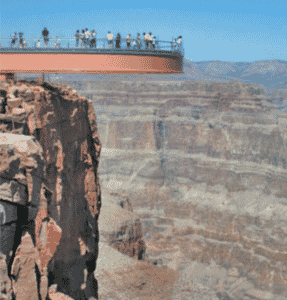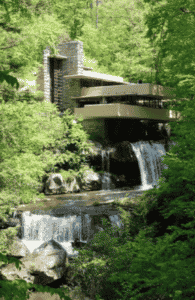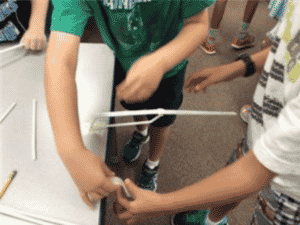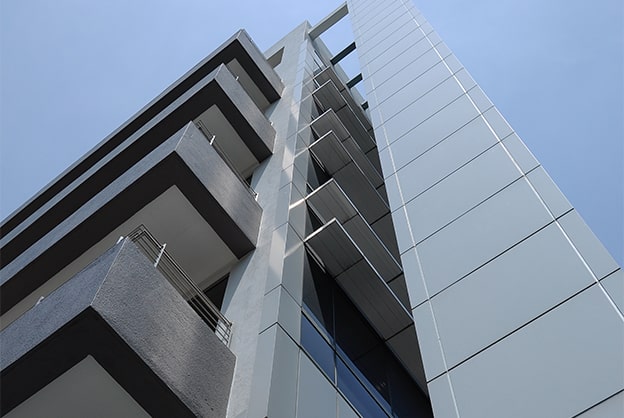Overview
Materials
Supplies & Equipment:
|
Consumables:
|
Relevant Terminology
Cantilever: An element of a structure that sticks out from, and is supported by, its base.
Fulcrum: The point on which a lever or cantilever rests.
Load: The weight that something must support. A diving board has to support the weight of the diver.
 The Grand Canyon Skywalk is a glass-bottomed cantilever. Credit: ComplexSimpleLLC/Wikimedia Commons. |
 Frank Lloyd Wright’s Fallingwater. This famous house makes extensive use of cantilevers. |
Introduce
GETTING READY
Set up tables or desks in an open space. Place 100 to 200 straws on each table, keeping several hundred in reserve. If using 6-foot tables, each table can accommodate several teams. If no tables are available, direct participants to build a cantilever that extends from the wall.
Cut strips of tape (3 feet or 1 meter) to give to each team.
INTRODUCTION
Have you ever stood on a diving board? What keeps it up?
Have you ever heard of a cantilever? A cantilever is a part of a structure that is only supported at one end, like a diving board, balcony, or airplane wing. Engineers use a variety of materials and techniques to make cantilevers feasible. Today you can try building a cantilever that hangs off a table as far as possible.
Stick your arm out straight to your side. It’s a cantilever!
- What force is working to pull your arm down? (Gravity.)
- How are you keeping your arm up under the force of gravity? (Muscles.)
- Imagine your arm is a cantilever balcony or part of a cantilever bridge. How strong would it have to be to support the weight of people or cars? What would keep the balcony or bridge from ripping away from its base?
Instructions
Introduce the design challenge: design and build a cantilever that hangs as far off a table as possible.
- You can use as many straws as you like but only 3 feet (or 1 meter) of masking tape.
- The cantilever cannot sag lower than 6 inches below the tabletop.
Participants work in small teams to build a cantilever. Encourage them to consider the force of gravity and plan a way for the table to support the weight of the cantilever. Some teams may discover that they can fit straws together without using tape. Some may decide to build a truss to provide strength.
- If participants are stuck or frustrated, help them by asking questions that can lead them to a solution—but try not to give solutions away.
Evaluate the success of each design. If time allows, redesign the cantilevers to make them longer.
ACTIVITY VARIATIONS

Participants build their cantilever of straws and masking tape. Credit: Knox Gifted Academy.
Have a contest to see who can build the cantilever that supports the most weight. Use a paper cup and string to make a bucket that hangs on the end of the cantilever. Add pennies until the cantilever fails.
Build the cantilever straight out from a wall.
Use alternative materials for the cantilever, like craft sticks, rolled newspaper, or uncooked spaghetti. Which material can make the longest cantilever?
TROUBLESHOOTING
If a team’s cantilever isn’t holding up under gravity, it may need to have more support at the base.
Guiding questions
GUIDANCE FOR PARTICIPANTS
QUESTIONS TO ASK AFTER THE ACTIVITY
- At what point did your cantilever topple? What do you think caused it to fall?
- What other materials do you think you could use to make your cantilever stronger?
- Where have you seen cantilevers in your community?
- How do you think cantilevers could be used to solve an architectural problem?
Engineering & science connections
GUIDANCE FOR PARTICIPANTS
Engineering Connections
Cantilevers are used as a design element in bridges, balconies, and viewing platforms. Visitors to the Grand Canyon can visit the Grand Canyon Skywalk, a 70-foot glass-bottomed cantilever platform that puts visitors high above the canyon bottom. The Cloud Bridge at Yunyang Longgang National Geopark in China is slightly longer; it extends 87.5 feet.
Fallingwater is the name of a house in Pennsylvania built by famous architect Frank Lloyd Wright. It was designed using cantilevers as the basis of the structure. Wright, inspired by the natural beauty surrounding the house, built the house over a waterfall. Fallingwater uses a boulder underneath the house as a fulcrum and additional stone outcrops to counterbalance the building’s weight and keep it from falling into the stream. Wright often used cantilevers in his designs in order to push the boundaries in architecture. Architects can’t accomplish their amazing designs without collaborating with engineers who help make their dreams a reality.
Science Connections
Cantilevers are an amazing feat of physics. Cantilevers can be found at work in many places, such as bridges, balconies, viewing platforms, and even at the local pool! Diving boards are a great example of a cantilever at work. The board extends over the pool to allow people to jump into the water.
Every cantilever has a fixed point called a fulcrum. In the case of the diving board, its fulcrum is the pool’s edge. For the board to work, it must be anchored, or counterbalanced, so that when you stand at the end of the board you don’t fall into the pool.
This activity was adapted from the ZOOM, pbskids.org/zoom/activities/sci/ cantilever.html. Used with permission from WGBH Educational Foundation.
TM/©2002 WGBH Educational Foundation. All rights reserved. ZOOM and ZOOM words and related indicia are trademarks of WGBH Educational Foundation. Used with permission. ZOOM is produced by WGBH Boston. Funding for ZOOM is provided by the the National Science Foundation, the Corporation for Public Broadcasting, The Arthur Vining Davis Foundations, and public television viewers. Any opinions, findings, and conclusions or recommendations expressed in this material are those of the author(s) and do not necessarily reflect the views of the National Science Foundation.
Supplemental content adapted for Dream Big Activities by the Carnegie Science Center.


0 Comments